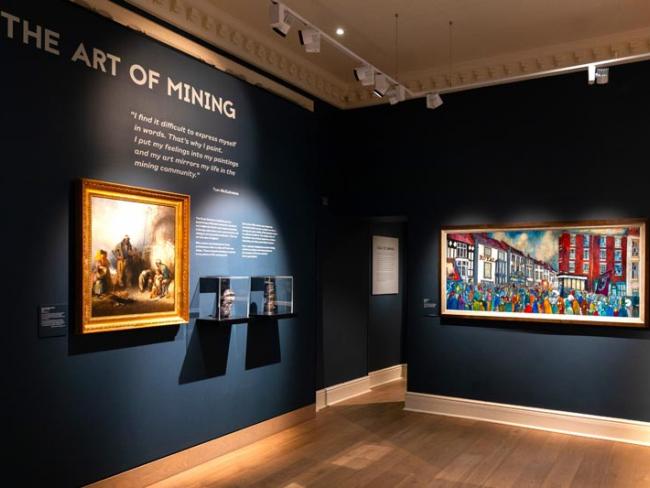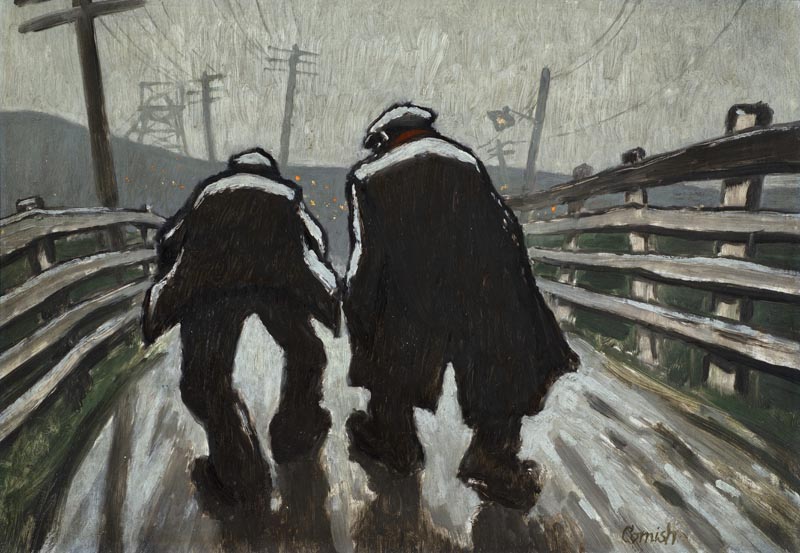
The display at the entrance to the Mining Art Gallery. Tom McGuinness’s Durham Big Meeting is on the wall to the right. Photo courtesy Mining Art Gallery, Bishop Auckland.
A gallery in Durham dedicated to art by and about miners and their community is part of Britain’s cultural legacy. It should be widely known…
Mining Art Gallery, Bishop Auckland. Tickets £30 for a year covering entry to the Mining Art Gallery, the Spanish Gallery, Bishop’s Palace and Gardens. Open Wednesday to Sunday plus Bank Holiday Mondays, 10:30 to 16:00. Free entry for carers, Art Fund members and children under 4.
A century ago mining was at the heart of Britain, employing 1.25 million people. And nowhere was mining more important than in County Durham, with 170,000 miners in 1923. The county’s landscape was dominated by winding gear and slag heaps.
Not now. It’s been more than 30 years since the last colliery in the Durham coalfield closed. A way of life – one that generated community and comradeship – has disappeared. But it is recorded, in pictorial form, in the Mining Art Gallery in Bishop Auckland.
What is unusual about the gallery is that its founders and many of the volunteers who show visitors round knew many of the artists whose works are represented there, making it a true community venture.
Visitors may be told, for example, about the “most important” work in the gallery, Durham Big Meeting by Tom McGuinness – important because this depiction of the Durham Miners’ Gala was the first picture bought by the gallery rather than donated.
Purchased at auction in Newcastle, Durham Big Meeting was brought back squeezed into an Austin Metro with the back seat folded down, and with the paint a little the worse for wear. So gallery founders Gillian Wales and Robert McManners asked McGuinness if he might “freshen it up” – which he did, adding the two founders into the crowd for good measure. It now hangs on the wall facing the entrance, the first picture that visitors see.
McGuinness came to mining later than some, being conscripted as a Bevin Boy in 1944. But when conscription ended he returned to mining, documenting the work and life of Durham miners in his spare time.
Knowledge
Notably, most of the pictures in the Mining Art Gallery were done by miners. They knew what they were painting, and they knew the people they painted. The result is a record of community without condescension or false sentiment. It is life as they experienced it. It is also testimony to the humanity of working people and their cultural creativity, so often untapped.
McGuinness wasn’t an artist before becoming a miner, but he honed his skills at the Spennymoor Settlement, an educational and self-help organisation founded in 1930. And it was the Settlement and its sketching classes, too, that nurtured a local talent, Norman Cornish.

Norman Cornish’s Pit Road – the road he walked to work for decades – painted sometime during the 1950s. Photo courtesy Mining Art Gallery, Bishop Auckland.
Cornish was born into mining, leaving school at 14 to go down the local pit. Working as a miner for four decades before finally turning professional as an artist, his work has been exhibited all over the North East yet only rarely outside, though he was the subject of a TV documentary by Melvyn Bragg in 1988.
Several of Cornish’s paintings hang on the gallery’s walls, including two of his favourite subjects: the pit road leading to Spennymoor – a path he trod for 40 years, and the mobile local landmark that was Berriman’s chip van.
The van was run by three brothers, of whom it was said that they worked in shifts. At any one time one brother would be peeling potatoes, one would be serving customers and one would be in the pub!
Cornish’s Crowded Bar, on display in the gallery, may be just one painting but it contains an entire world. The glasses of beer lined up on a table waiting for the miners coming off shift, all thirsty and all wanting a very quick pint. A whippet. A keenly contested dominoes battle.
Cornish would have been a familiar figure to all the men in the pub. He would come off shift himself and sit quietly sketching – his wife had sewn a poacher’s pocket into his coat so that he could carry his sketching materials wherever he went.
‘Cornish’s Crowded Bar may be just one painting but it contains an entire world…’
Other artists exhibited at the gallery include Bob Olley, who worked for 11 years in Whitburn Colliery near South Shields until it closed in 1968, and another Bevin Boy, Ted Holloway. Olley recently donated his gripping image of the notorious 1984 police attack on striking miners, Orgreave after Guernica; he was there himself. At the time of writing the 7 foot long painting hasn’t yet found space for permanent display.
It is certainly not a vast gallery – which makes it easy to visit – and one day it may need bigger premises. Already, as the memory of mining grows more remote and the people who bought works by local miners grow older, the gallery is frequently being offered paintings whose owners want them to be seen and appreciated.
It is clearly right and proper that such a gallery should be where it is, in the heart of former mining country. But this cultural legacy deserves also to be much more widely known throughout Britain.
Just around the corner in Bishop Auckland Town Hall, you can see – for free – other work by McGuinness and Cornish’s epic Miners Gala Mural, originally commissioned in 1962 for Durham’s new County Hall but now on permanent display in Bishop Auckland.
